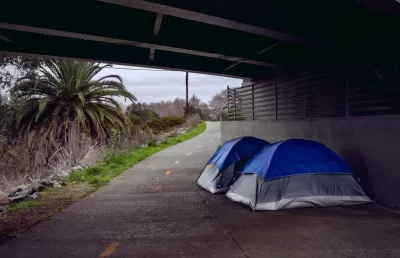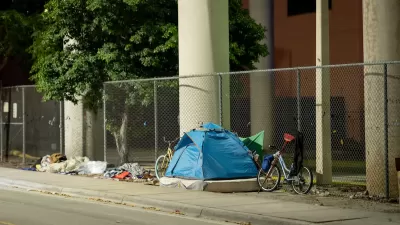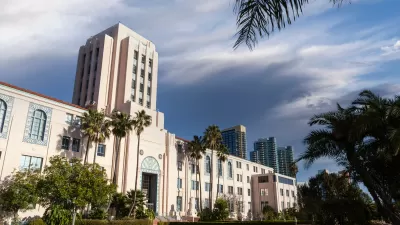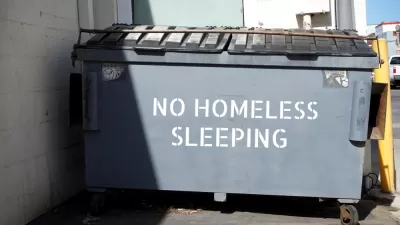An ordinance supported by the city’s mayor would bar people from sleeping on the street near shelters or services, but critics say it will simply push people to other neighborhoods and put them farther away from the supportive services they need.

A proposed San Diego city ordinance would “would bar camping on public property when shelter is available and within two blocks of shelters and schools, parks, open spaces and along waterways and transit hubs even when it’s not,” reports Lisa Halverstadt for Voice of San Diego.
According to the article, unhoused residents wouldn’t be allowed to set up tents near shelters and service providers even when there are no open beds available to them, which some residents worry will lead to an increase in people moving to other areas that lack any public services and cause people to lose contact with service providers. Halverstadt points out, “A lack of bed availability has for years hampered enforcement efforts – even as the city has opened hundreds of additional beds on [Mayor Todd Gloria]’s watch.” The city is banned by a 2018 court ruling from issuing citations for sidewalk sleeping when no shelter is available.
“Whitburn and Gloria argue that hundreds of unsheltered residents will be offered spaces at two new safe campgrounds that could collectively accommodate 500 tents and that there are plans to add more shelter beds too.” Unhoused residents expressed concern about the size and rules of the city-planned campsites.
California, which is home to roughly one-third of unhoused people in the United States, is one of the first recipients of funding from the federal ‘ALL INside’ initiative, which will offer assistance and support to states and cities for programs to address the homelessness crisis.
FULL STORY: What a Crackdown on Homeless Camps Could Mean for Neighborhoods

Planetizen Federal Action Tracker
A weekly monitor of how Trump’s orders and actions are impacting planners and planning in America.

San Francisco's School District Spent $105M To Build Affordable Housing for Teachers — And That's Just the Beginning
SFUSD joins a growing list of school districts using their land holdings to address housing affordability challenges faced by their own employees.

The Tiny, Adorable $7,000 Car Turning Japan Onto EVs
The single seat Mibot charges from a regular plug as quickly as an iPad, and is about half the price of an average EV.

Trump Approves Futuristic Automated Texas-Mexico Cargo Corridor
The project could remove tens of thousands of commercial trucks from roadways.

Austin's First Single Stair Apartment Building is Officially Underway
Eliminating the requirement for two staircases in multi-story residential buildings lets developers use smaller lots and more flexible designs to create denser housing.

Atlanta Bus System Redesign Will Nearly Triple Access
MARTA's Next Gen Bus Network will retool over 100 bus routes, expand frequent service.
Urban Design for Planners 1: Software Tools
This six-course series explores essential urban design concepts using open source software and equips planners with the tools they need to participate fully in the urban design process.
Planning for Universal Design
Learn the tools for implementing Universal Design in planning regulations.
Smith Gee Studio
City of Charlotte
City of Camden Redevelopment Agency
City of Astoria
Transportation Research & Education Center (TREC) at Portland State University
US High Speed Rail Association
City of Camden Redevelopment Agency
Municipality of Princeton (NJ)





























